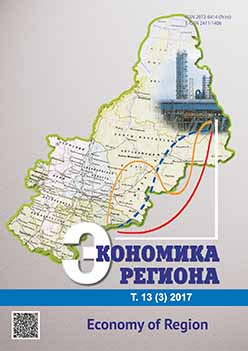Территориальное распределение населения в Российской Федерации
Territorial Distribution of the Population in the Russian Federation
Author(s): Vsevolod Vladimirovich AndreevSubject(s): Economy
Published by: Институт экономики Уральского отделения Российской академии наук
Keywords: Gibrat’s law; Zipf ’s law; lognormal distribution; non-equilibrium distribution; Pearson fitting criterion; population migration; laws of spatial distribution of population; drivers of population mobi
Summary/Abstract: In 1931, Robert Gibrat found that the number of the employees of a firm and urban population follow the lognormal distribution. Numerous studies results show that the Gibrat’s law provides a basis for the analysis of the dynamics of the number of the employees of mature and large firms, which have already carved out a niche. Furthermore, the Gibrat’s law allows analyzing the dynamics and laws of the spatial distribution of the population of different countries in a case if their socioeconomic development is sustainable and equilibrium. The purpose of the study is testing the Gibrat’s law for Russian cities and towns of different sizes. If the Gibrat’s law is valid, we can conclude that the spatial distribution of the population in the country is equilibrium and the labour distribution is close to optimal. The opposite result demonstrates the imbalance between the allocation of manufacture and labour force. The author took 2010 national census results as source data. I have tested the hypothesis of the lognormal law of population distribution in Russia over different cities and towns using the Pearson fitting criterion with the value a = 0,05. The results of the study have shown that the distribution of the population over Russia does not follow the Gibrat’s law. As a result, the distribution of the population is uneven, which translates into the significant labour migration from settlements with the small population to large cities. The knowledge of the laws of the territorial distribution of the population and driving factors of population mobility is of importance for the development and implementation of effective socio-economic policy in the country. The definition of the population distribution imbalance over various population centers and the development of recommendations for the creation and optimal location of new production in the country may be the promising area for future research. The study of spatial clustering of population centers and comparative analysis of such clusters with Russian regions in their current administrative borders are important as well.
Journal: Экономика региона
- Issue Year: 13/2017
- Issue No: 3
- Page Range: 803-811
- Page Count: 9
- Language: Russian

